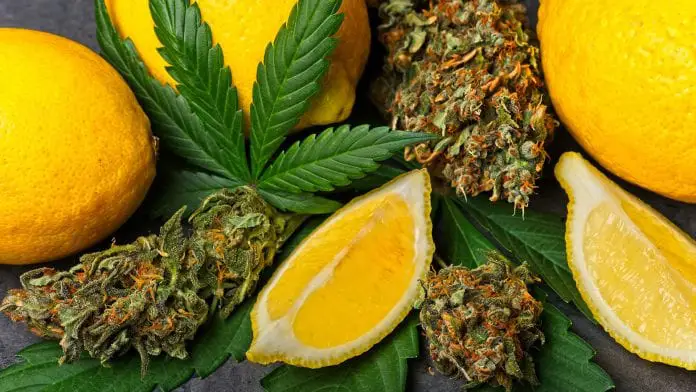The lesser known modulator
Current hemp legalization legislation has sparked renewed interest in cannabis/hemp compounds for medicinal and recreational uses. As individuals progress in their cannabis/hemp learning curve, they typically become familiar with the effects of CBD (cannabidiol) and THC (tetrahydrocannabinol), thus forming their evaluation criteria when presented with a range of cannabis products.
Traditionally, the industry has centered its focus on a product’s THC and CBD content as a measure of potential effects. Generally speaking, increased THC correlates to a feeling of high, while minimal THC combined with concentrated CBD leans toward a more relaxing experience. More recently, the industry has witnessed the combination of CBD with adaptogens (herbal supplements) to target specific user outcomes.
However, the spotlight is shifting toward terpenes!
Terpenes: These aromatic oils found in cannabis plants contribute to unique scents and flavors. Think about the scent of basil – that lovely aroma is made possible by a specific terpene called Humulene. Hemp and cannabis boast complex terpene combinations naturally synthesized by the plant to provide flowers with natural defense and nutrition for total survivability.
Cannabinoids: The connection between terpenes and cannabinoids is crucial. CBD and THC, along with terpenes, exhibit the entourage effect, where combined effects are more potent and nuanced than individual effects.
Entourage Effect: This concept explains the synergistic interactions between terpenes and cannabinoids, enhancing the overall effects of cannabis consumption.
Aroma and Flavor: Terpenes play a significant role in shaping the aroma and flavor of different cannabis strains. For instance, lavender (Linalool) and mangoes (Myrcene) contribute distinct scents and flavors.
Terpene Profile: Understanding a cannabis strain’s terpene profile is crucial. Matching personal preferences to specific terpene profiles enhances the cannabis experience.
Terpene Education: Recognizing the growing demand for terpene information, educational resources are increasingly available. There are recent studies that the terpene content in the extracts increases the bioavailability of cannabinoids by around 50%. It’s essential to understand that the terpenes are the necessary component for quality cannabis oil.
Now, picture a vast field of fresh flowers; wouldn’t you want to smell them? Visual beauty is exclusive to those with vision, but what if smell and taste were your only senses? Suddenly, scent becomes critical, and that package becomes dead weight. But it’s that scent we’ve endeavored to capture.

Today’s market discusses terpenes and their vital role in the power of effects produced by hemp-based products. However, most terpenes in today’s hemp-based products originate from botanical sources like basil (Humulene), lavender (Linalool), mangoes (Myrcene), and are then combined in the laboratory to create terpene profiles traditionally found in hemp or cannabis flowers.
At PURE5™, we’ve achieved a high-level dynamo where terpene profiles can be leveraged to target specific end-user outcomes.
Terpene Analysis and Testing: Delving into terpene analysis methods, testing methods, and the interpretation of terpene test results provides valuable insights for consumers and cannabis professionals.
Terpene-Specific Effects: While the entourage effect is well-explained, delving deeper into the potential specific effects of individual terpenes further educates consumers about the potential benefits of different strains based on their terpene profiles.
Terpene Interactions with Other Compounds: Expanding on the interactions of terpenes with other compounds in cannabis, such as flavonoids and pigments, provides a more holistic understanding of the complex chemical processes involved.
Terpene Applications Beyond Cannabis: Highlighting the broader applications of terpenes in various industries, including aromatherapy, cosmetics, and food flavoring, broadens the understanding of their versatility and potential health benefits.
Terpene Research and Future Directions: Addressing current research trends and future directions in terpene research provides a glimpse into the ongoing exploration of these fascinating compounds and their potential applications.
Now, let’s take a closer look at some specific terpenes and their characteristics:
For example, botanical terpenes are combined to form a specific terpene profile, offering enhanced end-user effects and a unique flavor. Our Dry Flower Full Spectrum Oil (FSO) exemplifies this approach. Conversely, our Fresh Flower Live Resin Oil product line is made possible by our state-of-the-art extraction process, capturing all naturally occurring terpene profiles, providing users with a true, fresh flower oil directly derived from the plant. This is the power of The Low Low.
Our extraction reactor, nicknamed The Low Low, captures the flower’s natural essence in a highly concentrated form, underscoring the PBX-STANDARD. Our hemp terpenes are produced using a non-destructive pure botanical extraction process, capturing all terpenes in an unaltered profile, suspended in natural plant oils.
Starting with the highest quality hemp flower and coupled with Pure Botanical Extraction (PBX-STANDARD), our products contain the highest concentration of naturally occurring terpenes. Explore a sample of our terpene profiles below, showcasing the full spectrum of terpenes present in our PBX Oils. Technically, we can claim to capture all terpenes present in the flowers we extract.
Continue your exploration of The Low Low for a clearer understanding of how and why.
For enquiries please contact:
George Stantchev, PhD
+1 (602) 992-0744
www.pure5extraction.com








